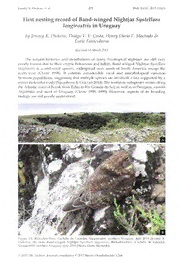
First nesting record of Band-winged Nightjar Systellura longirostris in Uruguay PDF
Preview First nesting record of Band-winged Nightjar Systellura longirostris in Uruguay
Jeremy K, Dickens et al. 278 Bull. B.O.C. 2015 135(3) First nesting record of Band-winged Nightjar Systellura longirostris in Uruguay hif Jeremy K. Dickens, Thiago V. V. Costa, Henry Dario F. Machado & Enric Fontciiberta Received 31 March 2015 The natural histories and distributions of many Neotropical nightjars are still very poorly known due to their cryptic behaviour and habits. Band-winged Nightjar Systellura longirostris is a mid-sized species, widespread over much of South America, except the north-west (Cleere 1998). It exhibits considerable vocal and morphological variation between populations, suggesting that multiple species are involved, a fact supported by a recent molecular study (Sigurdsson & Cracraft 2014). The nominate subspecies occurs along the Atlantic coast of Brazil, from Bahia to Rio Grande do Sul, as well as in Paraguay, eastern Argentina and most of Uruguay (Cleere 1998, 1999). However, aspects of its breeding biology are still poorly understood. Figure lA. Bichadero-Froz, Cuchilla de Laureles, Tacuarembo, northern Uruguay, July 2014 (Jeremy K. Dickens); (B) male Band-winged Nightjar Systellura longirostris, Bichadero-Froz, Cuchilla de Laureles, Tacuaremho, northern Uruguay, July 2014 (Henry Dario Machado) © 2015 The Authors; Journal compilation © 2015 British Ornithologists' Club Jeremy K. Dickens et al. 279 Bull. B.O.C. 2015 135(3) Figure 2. Nesting Band-winged Nightjar Si/stellurn longirostris, Bichadero-Froz, Cuchilla de Laureles, Tacuarembo, northern Uruguay: (A) female and ecloded eggs, September 2013; (B) nestlings, October 2013 (Henry Dario Machado) We present the first report of S. longirostris nesting in Uruguay, with a description of eggs and nestlings. A nesting S. longirostris was recorded in September-October over two consecutive years (2012-13) at Bichadero-Froz, Cuchilla de Laureles, Tacuarembo, northern Uruguay (31°21'34.2"S, 55°59'4.8"W). Habitat comprised rocky outcrops, with several small streams, at the edge of a densely foresfed gorge in an area otherwise characterised by heavily grazed open pampas (Fig lA). In late September 2013, the nest possessed two nearly pure white eggs, with several almost imperceptible pale brown spots. These were incubated by the female when photographed (Fig. 2A). The eggs were laid on a patch of soft lichens and bryophytes, with a few pebbles, and not directly onto the bare rock. It was unclear whether the pebbles in the nest were naturally present or if they had been placed there by an adult. On the next visit, c.lO days later, in early October, two pale tan-brown nestlings were observed at exactly the same spot (Fig. 2B). In July 2014, two S. longirostris were found roosting together during the day on the rocky outcrop at Bichadero-Froz. The first, a male, was photographed (Fig. IB) and, when flushed, flew into the gorge and took cover in the forest with the second, which was identified as a female but was not photographed. This male had an unusual rufous plumage, superficially similar to Rufous Nightjar Antrostomus rufiis, but was identified using the following traits: somewhat uniform upperparts, without any conspicuous scapular pattern; dark remiges with a semi-concealed buff band; and the fairly extensive white tips to the inner webs of the two outermost rectrices (visible in the photo). The incubating female also had an atypical, pale, plumage, but the overall pattern of the upperparts, with no conspicuous markings on the head, nape and scapulars, ensures its identification. The breeding season coincides with that already reported for this subspecies, September to December, with the only previous data coming from records in Rio de Janeiro (Sick 1997) and Minas Gerais (Hoffmann 2010), in south-east Brazil, and in Santa Fe province, Argentina (de la Pena 2006). Egg and chick coloration and clutch size are also similar to those mentioned in the literature. However, they differ from the other nesting records by being laid onto a soft substrate, not bare rock, and hatching via the middle of the egg, not the broader end. Their breeding at the same locality in two consecutive years and presence in a third is suggestive of nest-site fidelity. This study reinforces the need for © 2015 The Authors; Journal compilation © 2015 British Ornithologists' Club Jeremy K. Dickens et al. 280 Bull. B.O.C. 2015 135(3) additional studies on the breeding biology of Neotropical nightjars, especially for species whose taxonomy is unclear and comprise various vocally and/or morphologically distinct forms, such as S. longirostris. Acknowledgements We thank the Froz family for their hospitality during our stay on the Bichadero and Guy Kirwan, Alex Lees, Adrian Azpiroz and Luis Fabio Silveira for discussing the identification of the nightjars. Adrian Azpiroz also made valuable suggestions on the submitted version of the manuscript. References: Cleere, N. 1998. Nightjars. A guide to nightjars and related nightbirds. Pica Press, Robertsbridge. Cleere, N. 1999. Family Caprimulgidae (nightjars). Pp. 302-386 in del Hoyo, J., Elliott, A. & Sargatal, J. (eds.) Handbook of the birds of the world, vol. 5. Lynx Edicions, Barcelona. Hoffmann, D., Epifanio, A. D. & Vasconcelos, M. F. 2010. Nesting of Band-winged Nightjar Caprimulgiis 1. longirostris in eastern Brazil, including the first description of chicks. Cotinga 32: 142-145. de la Pena, M. R. 2006. Reprodiiccion de las aves argentinas (con descripcion de pichones). Literature of Latin America, Buenos Aires. Sigurdsson, S. & Cracraft, J. 2014. Deciphering the diversity and history of New World nightjars (Aves: Caprimulgidae) using molecular phylogenetics. Zoo/. /. Linn. Soc. 170: 506-545. Addresses: Jeremy K. Dickens & Thiago V. V. Costa, Museu de Zoologia da Universidade de Sao Paulo, Av. Nazare, 481, Ipiranga, CEP 04218-970, Sao Paulo, SP, Brazil, e-mails: [email protected], tvvcosta® usp.br. Henry Dario F. Machado & Enric Fontcuberta, Posada Bichadero, Cuchilla de Laureles, dpto. Tacuarembo, Uruguay, e-mails: [email protected], [email protected] © 2015 The Authors; Journal compilation © 2015 British Ornithologists' Club
